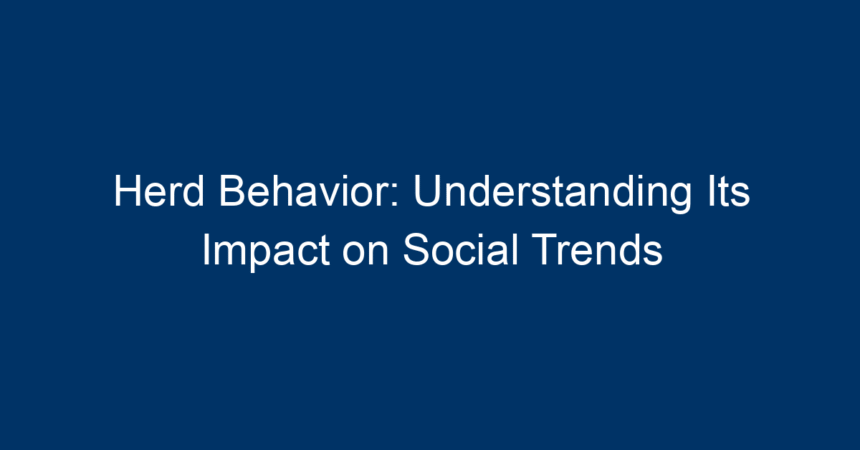In an age where social media amplifies our collective voices, the phenomenon of herd behavior is more relevant than ever. Defined as the tendency of individuals to follow the actions of a larger group, herd behavior can be seen across various contexts—from financial markets to social movements. This article delves into the complexities of herd behavior, exploring its influence on social trends, consumer behavior, and decision-making processes.
What is Herd Behavior?
Herd behavior refers to the phenomenon where individuals in a group act collectively without centralized direction. This behavior often leads to actions that deviate from individual rationality. While herd behavior can spur innovation and solidarity, it can also lead to misguided actions and negative consequences. Understanding herd behavior can help us navigate social dynamics and consumer trends, ultimately leading to more informed decisions.
The Psychological Basis of Herd Behavior
The psychology behind herd behavior is rooted in several cognitive biases and social dynamics. Here are a few key components:
-
Social Proof: Humans are social creatures, and we often look to others for cues on how to behave. When we see a group of people doing something, we may conclude that it is the correct action.
-
Cognitive Dissonance: Individuals often strive for consistency in their beliefs and actions. When faced with conflicting information—such as a majority’s opinion versus an individual’s—people may conform to the majority to reduce psychological discomfort.
- Fear of Missing Out (FOMO): In today’s digital age, FOMO has propelled herd behavior, especially among millennials and Gen Z. The desire to belong can drive individuals to engage in trends and behaviors they might not otherwise choose.
Examples of Herd Behavior in Social Trends
Understanding herd behavior is crucial to grasp its impact on social trends. Here are three notable examples:
1. Financial Markets
Herd behavior is most apparent in financial markets. Investor sentiment can mimic herd dynamics, often driving stock prices up or down irrespective of a company’s fundamentals.
-
Bull Markets: During a bull market, investors rush to buy stocks, driven by the belief that they will keep increasing in value. This can lead to bubbles, as seen in the dot-com bubble and the 2008 financial crisis.
- Panic Selling: Conversely, during market downturns, the fear of losing money can lead to widespread panic selling, creating further declines in prices.
2. Fashion Trends
Fashion serves as another canvas for herd behavior. The rise of fast fashion has been fueled by consumers who see what celebrities and influencers wear, leading to a swift adoption of these trends.
- Viral Fashions: Trends can go viral overnight thanks to social platforms like Instagram and TikTok, where individuals flock to replicate the looks of influencers. Think of the viral ‘dad sneaker’ trend, which saw mass adoption simply because it was deemed stylish by a few popular figures.
3. Social Movements
Herd behavior does not only manifest in consumer choices but also in social movements. The global climate strike, for example, showcases how collective action can mobilize thousands, sparking a trend toward environmental activism.
- Online Activism: The #MeToo movement illustrates herd behavior with individuals sharing their stories after seeing others do the same, creating a ripple effect that has transformed social dialogue around sexual harassment and gender equality.
The Positive Side of Herd Behavior
While herd behavior can lead to negative outcomes, it also has beneficial aspects:
1. Collective Problem-Solving
Herd behavior can lead to innovative solutions during crises. For instance, during the COVID-19 pandemic, communities came together to share resources, information, and help each other, illustrating the potential of collective action.
2. Spreading Awareness
Social movements often gain momentum through herd behavior. Movements advocating for rights and awareness (like LGBTQ+ rights or mental health awareness) can grow rapidly as more individuals join in, amplifying their reach and impact.
The Negative Consequences of Herd Behavior
Despite its positive aspects, herd behavior can also have detrimental effects:
1. Misinformation
In the age of social media, misinformation can spread rapidly through herd behavior. When individuals blindly accept information because "everyone else believes it," harmful narratives can entrench themselves, leading to societal divisions.
2. Poor Decision-Making
Herd behavior can also lead to poor decisions. From financial investments to societal norms, a lack of critical thinking resulting from group conformity can escalate to severe consequences. The case of the housing market crash is a testament to how collective irrationality can decimate economies.
3. Social Stigmatization
Herd behavior can lead to the ostracization of individuals who think differently, fostering environments where conformity is prioritized over diverse thought. This can suppress innovation and marginalize minority voices.
Navigating Herd Behavior: Actionable Insights
Understanding the forces that drive herd behavior can equip individuals and organizations to navigate this aspect of social dynamics effectively. Here are some actionable insights:
1. Cultivate Critical Thinking
Encourage critical analysis and independent thinking within social and professional settings. This can help mitigate the negative impact of herd behavior and promote informed decision-making.
2. Embrace Diverse Perspectives
Fostering an environment where diverse opinions are respected can limit the uniformity that herd behavior often engenders. Celebrate differences and encourage discussions that question the norm.
3. Use Social Media Responsibly
Engage with social media mindfully. Be aware of how trends and narratives can shape your perceptions and actions. Sharing credible information and challenging misinformation can help build a more informed community.
4. Align with Core Values
Engage in social behaviors and trends that align with personal or organizational values instead of simply following the crowd. This fosters authenticity and promotes meaningful participation in societal movements.
Conclusion: Harnessing Herd Behavior for Positive Change
Herd behavior is an inherent part of social dynamics, influencing our decisions, values, and actions. Recognizing the signs of herd behavior can help mitigate its negative impacts while unleashing its potential for collective problem-solving and social progress.
By cultivating critical thinking, embracing diversity, and using platforms wisely, individuals can navigate the complexities of herd behavior. In an increasingly interconnected world, understanding and harnessing herd behavior can lead to positive social trends that benefit everyone. Whether in the context of financial markets, fashion, or social movements, being aware of herd behavior opens up new avenues for innovation and collaboration.




